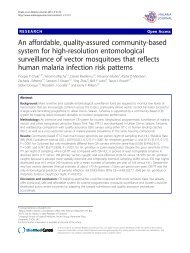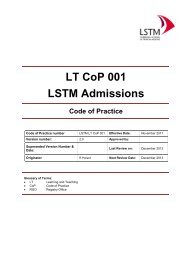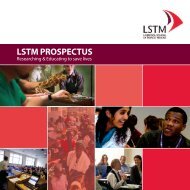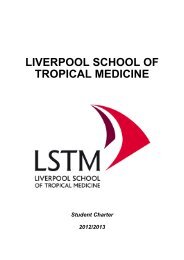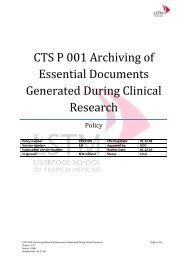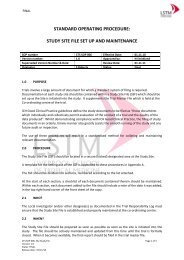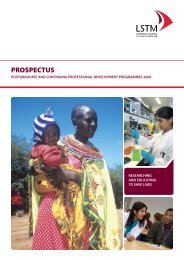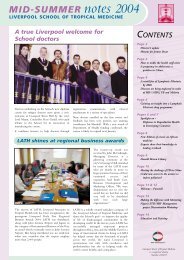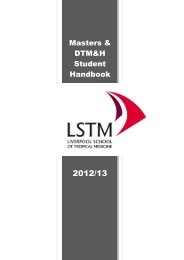Gender influences on child survival, health and nutrition: a ... - Unicef
Gender influences on child survival, health and nutrition: a ... - Unicef
Gender influences on child survival, health and nutrition: a ... - Unicef
You also want an ePaper? Increase the reach of your titles
YUMPU automatically turns print PDFs into web optimized ePapers that Google loves.
<str<strong>on</strong>g>Gender</str<strong>on</strong>g> Influences On Child Survival, Health And Nutriti<strong>on</strong>: A Narrative Review<br />
improved care practices for their <strong>child</strong>ren. However there are also other important resources which may<br />
also be allocated unevenly between women <strong>and</strong> men.<br />
Researchers have drawn links between women’s access to <strong>and</strong> c<strong>on</strong>trol over financial assets <strong>and</strong><br />
improved nutriti<strong>on</strong>al outcomes <strong>and</strong> <strong>health</strong> preventative behaviours for their <strong>child</strong>ren. For example<br />
large-scale quantitative surveys c<strong>on</strong>ducted in the following countries found that:<br />
‣ In Bangladesh parental asset statistics showed that a higher proporti<strong>on</strong> of pre-wedding assets 5<br />
held by mothers decreased the morbidity of preschool girl <strong>child</strong>ren (coefficient of illness days = -<br />
2.317; z-score = -2.08). While a higher share of current assets held by father reduced preschool<br />
boys’ morbidity (coefficient of illness days = -2.054; z-score = -1.94) (Hallman 2003);<br />
‣ In Brazil income accruing to women had a larger positive impact <strong>on</strong> <strong>child</strong> nutriti<strong>on</strong>al status<br />
(weight-for-height was 0.0329; height-for-age was 0.0255) in comparis<strong>on</strong> with income accruing<br />
to men (weight-for-height was 0.0040; height-for-age was 0.0058) measured as total Two-Stage<br />
Least Squares (Thomas 1997);<br />
‣ In India (in urban poor areas) the likelihood of <strong>child</strong>ren not receiving vaccinati<strong>on</strong>s was<br />
significantly associated with a mother’s lack of financial aut<strong>on</strong>omy (odds ratio=0.6267; 95%<br />
c<strong>on</strong>fidence interval=0.4084-0.9615), <strong>and</strong> with lack of educati<strong>on</strong>al attainment (odds<br />
ratio=0.2384; 95% c<strong>on</strong>fidence interval 0.0791-0.7178) (Agarwal & Srivastava 2009).<br />
Box 4: Women’s purchasing power<br />
A study undertaken in Benin combining quantitative <strong>and</strong> qualitative methods dem<strong>on</strong>strates <strong>on</strong>e<br />
of the pathways in which income in the h<strong>and</strong>s of women may provide better outcomes for<br />
<strong>child</strong>ren. Quantitative surveying of 191 households found that women’s income was <strong>on</strong>e of the<br />
key variables that predicted household use of a bed-net. Qualitative interviewing involving men<br />
<strong>and</strong> women in sex-disaggregated Focus Group Discussi<strong>on</strong>s (23) <strong>and</strong> semi-structured interviews<br />
(16) found that women who were able to earn income were more likely to purchase insecticidetreated<br />
bed-nets which would then be available for use by their <strong>child</strong>ren. The study found <strong>on</strong> the<br />
other h<strong>and</strong> that bed-nets which had been purchased by the male head of household were more<br />
likely to be used by men themselves as they perceived their own need as greater, given their<br />
breadwinning role in the household (Rashed et al. 1999).<br />
REVIEW OF STUDIES<br />
5 Household survey data from 47 villages in three rural areas in Bangladesh are used. Besides detailed informati<strong>on</strong><br />
<strong>on</strong> agriculture <strong>and</strong> nutriti<strong>on</strong>, the survey also c<strong>on</strong>tains data <strong>on</strong> individual current asset holdings, premarital assets,<br />
marriage transfer payments, <strong>and</strong> family background characteristics for husb<strong>and</strong>s <strong>and</strong> wives. Resource c<strong>on</strong>trol is<br />
measured by maternal share of current assets, maternal share of premarital assets <strong>and</strong> maternal share of marriage<br />
payments.<br />
18



